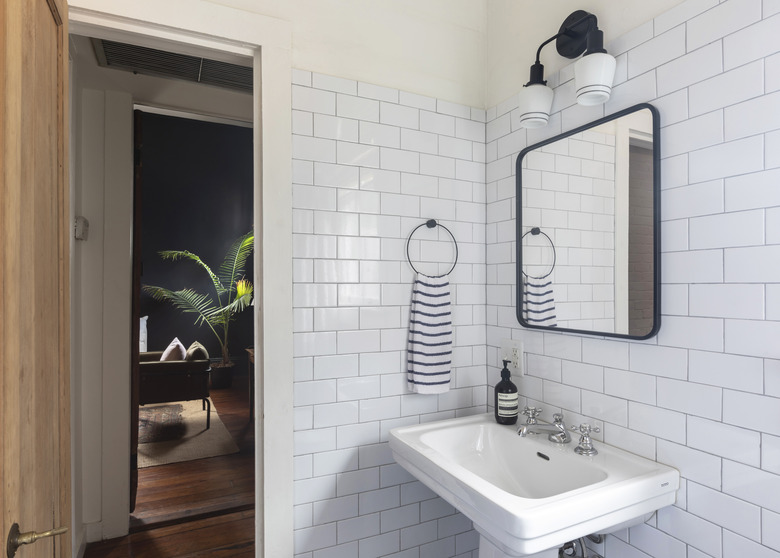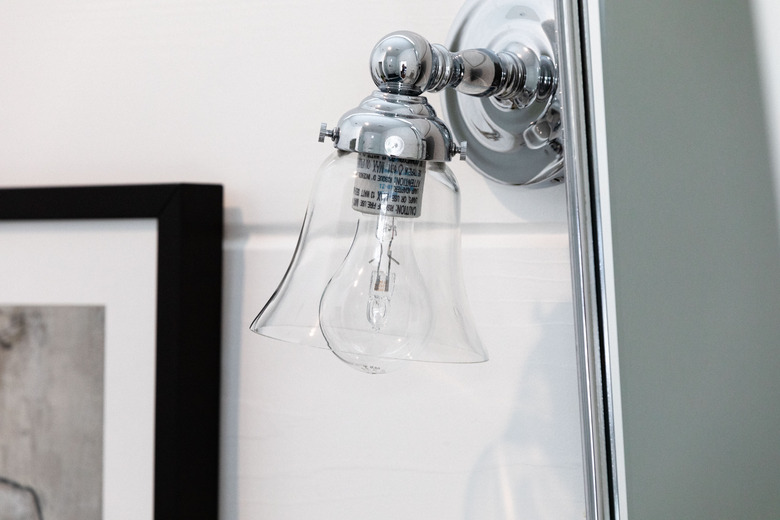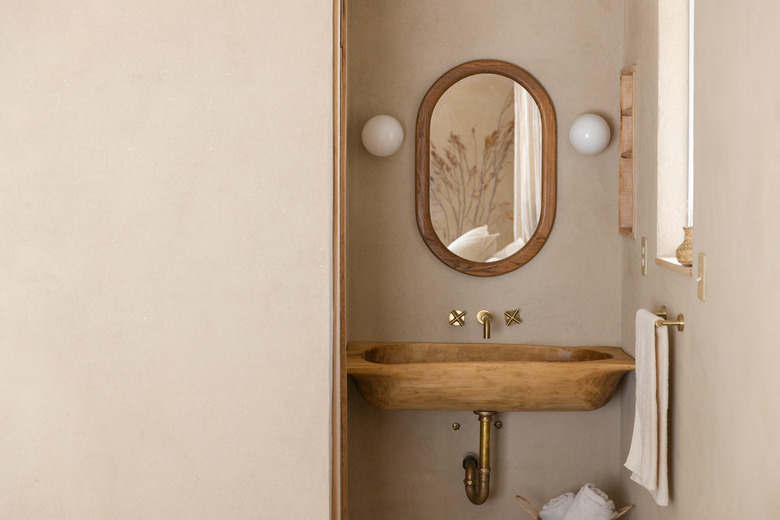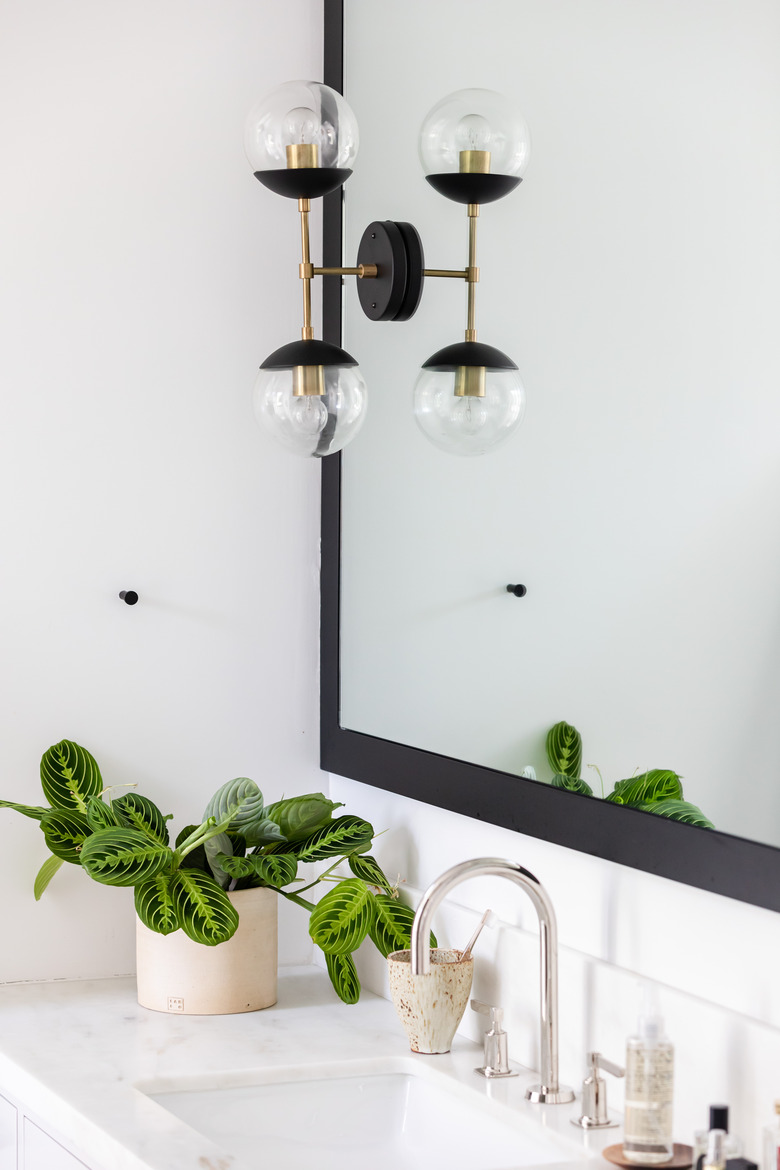How To Perfectly Light Your Bathroom
Any overall bathroom lighting guide includes a decorative aspect, but in the end, it's really the layout and design that make everything come together perfectly. There are a number of different ways to make the lighting in this room both functional and fabulous. These include things like incorporating natural light, understanding the differences between task lighting and ambient lighting and knowing the right type of bulbs to use in the space. Everything begins with an overall plan for the lighting design.
Most homeowners will want to hire a professional electrician to tackle the actual work of installing the lights, but that doesn't mean they should hand off the layout and selection of fixtures. Although it may seem fairly easy to pick out bathroom lights, there are actually quite a few considerations that need to be taken into account before shopping. Doing some homework on how to design lighting for this space is key to making sure it looks amazing. Armed with some knowledge, this is a DIY task that can yield great results.
Understand the Different Lighting Types
Understand the Different Lighting Types
Bathroom lighting comes in a variety of different forms, and each is important for a specific reason. While you don't have to incorporate all of them in each of your bathroom spaces, layering different lighting styles for a full range of options gives you a number of profiles from which to choose. This means the room can be used for practical purposes, to set a mood or to highlight certain design features, such as a decorative bathroom mirror or a piece of art. Use various types of fixtures as a basic bathroom lighting guide for best results.
Begin With Ambient/General Lighting
Begin With Ambient/General Lighting
This is the standard type of light that provides illumination for people going in and out of the room, usually for short periods of time, such as getting a tissue or washing hands. Often referred to as ambient light, it serves a more practical function although the fixtures can certainly be decorative. Recessed can lights are an example of bathroom ceiling lights. When deciding on placement, be sure the light from an overhead fixture won't shine directly down on your head when you stand in front of the vanity.
Good lighting design uses as much natural light as possible in the bathroom but should also provide privacy. This can be accomplished by putting in frosted or patterned glass, using curtains or taking advantage of a skylight if that is a possibility. If the project is a remodel, then the window size may already be set, but if not, consider something that lets ample light into the bathroom space.
Add Bright Task Lighting
Add Bright Task Lighting
Task lighting is the light used for doing things like grooming, applying makeup, getting a splinter out of a child's finger or putting in contacts. It needs to be bright to enable household members to get a close-up look at things. This type of lighting is most needed near the vanity and in the shower area but is sometimes included in storage areas or linen closets. Make sure any fixtures used in storage spaces comply with the local code for fire safety before purchasing them.
Wall sconces are among the most popular task lights in just about any bathroom lighting plan. When placed on either side of the mirror above the bathroom vanity, they provide bright, even light that doesn't cast odd shadows. The rule of thumb is to position them at or a little above eye level for best results. This is somewhere between 5 1/2 and 6 feet for most adults. Some people use lighting above the mirror, but this is more likely to create shadows. These days, you can also opt for a vanity mirror that features built-in LED lighting.
Consider Accent/Mood Lighting
Consider Accent/Mood Lighting
Also known as mood lighting, this kind of light is included in a bath area primarily for effect. It can be anything from using a dimmer on an overhead fixture to elaborate undercabinet lighting strips. Accent lights create an inviting look for the bathroom space when the area isn't being used for practical purposes. Often but not always, an accent light can also be a decorative fixture that is a focal point in the room.
Accent lights may be used to show off fancy tile layouts or wash a wall with a warm or cool color. Some lighting manufacturers also offer bulbs that change colors. Floating bathroom vanities have become popular, and installing a light below that gives the floor a nice flood of light can look amazing. It's a good idea to keep accent lighting on a separate switch from task lighting since they serve different purposes.
Look at Decorative Lighting
Look at Decorative Lighting
This is the lighting that adds a "wow" factor to the room, and it really refers to the actual fixture itself. These can be anything from an intricate glass globe pendant to a fancy crystal chandelier, and these items are able to really dress up the bathroom. These days, there are many options for lights that have style, and they are turning up more and more often in the bathroom space. Light fixtures have really become a focal point.
Just about any light can be decorative while serving as ambient, task or accent lighting. Make sure these lights are positioned in a safe place, as some are not suitable for over a tub or in a shower space. Once again, be sure to check the rating on these fixtures to ensure they will work with local code for the bathroom space. Not all decorative lights will be safe to use near water or in wet areas.
Personalize the Bathroom Lighting Design
Personalize the Bathroom Lighting Design
To maximize the lighting design's usefulness and appeal, it makes sense to think about how each bathroom will be used. For example, a child's bathroom may need less accent lighting, but a nightlight could be a smart feature to include. Tailoring the lighting to the needs of the people that will be using that space is a key part of any bathroom lighting guide. This will not only help with fixture choices but will also help dictate the placement.
Powder rooms are an excellent place to invest in mood lighting, as they are often the bathroom in the home that is on display for visitors. Hang a stylish pendant over the pedestal sink or vanity space and put it on a dimmer for dramatic effect and also to help guests navigate. Strip or rope lights are another way to add interest to a powder room, and they can be used as an uplight above cabinetry, incorporated into a shelving area or used down low in the toe-kick area.
Master baths are private spaces and ideally should feature a lighting design specific to the people using the room. Homeowners appreciate a spa-like feel in this space, and this can be accomplished through a combination of dimmers and accent lighting. This is also an important area for getting ready for the day, so task lighting also needs some serious consideration. One of the newer features being used is a swing-out makeup mirror with built-in lighting. These can be installed in a cabinet for a more streamlined design.
Take advantage of technology when appropriate as well. There are nightlights that go on automatically when the room light is low, making them a great addition for bathrooms that may be used in the middle of the night. There are also motion-sensor lights that trigger a fixture when someone walks into the room. Fancy dimmers can be programmed to come on at a particular light level or to go off gradually over a period of time. There are a lot of wonderful options.
Decide on Bathroom Lighting Placement
Decide on Bathroom Lighting Placement
Although it's important to choose the right type of light for the bathroom space, it's equally critical to put each type of lighting in the spot that makes the most sense. This can be a challenge, so it pays to take some time to map out the lighting design locations ahead of time to make sure every area of the room is covered. A good lighting design will be balanced, layered and functional as well as serve to highlight any design features. Powder rooms may not need as many options, as they generally aren't used for getting ready.
Local electrical codes must also be observed when laying out lighting and switch placement. Each city/town can supply access to the code required for electrical work. Licensed electrical contractors have the experience and expertise to do this type of installation properly, which is important for safety. Specifics include things such as making sure shower fixtures are correctly rated and light switches are placed in a safe location.
Consider Bulbs, Wattage and Dimmers
Consider Bulbs, Wattage and Dimmers
Bathrooms that function as places where family members groom and get ready for the day will require the most careful consideration. Task lighting will be important in these spaces, and it will need to be bright enough to easily see when shaving, putting on makeup or taking a shower. Although professional recommendations vary, they tend to range somewhere in the 75- to 150-watt range (or the LED equivalent). It's a good idea to go bright and use a dimmer to tone things down when a full blast of power isn't needed.
Color temperature is another detail to consider in the bathroom space. Most people are using LED lights now, but these bulbs give off very different light profiles, and not all are suitable for task or mood lighting. These lights are measured on the Kelvin scale, and they range from 1,000 K to 10,000 K. Westinghouse suggests that bulbs from 4,600 K to 6,500 K best mimic daylight and work well for task lighting, while bulbs in the 2,000 K to 3,000 K range are warmer and work well for ambient light.
Dimmers are a wonderful tool for lighting design, and they can be used with any of the lights in the bathroom area. Accent lighting on a dimmer can be especially appealing, as it can be adjusted easily based on the time of day to give the effect that is desired. Add a warm glow or wash a wall with a subtle spot for a bit of dramatic flair. Remember that in order to use dimmers on LED lights, the bulbs must state that they are dimmable on the package.
In addition to making sure the fixtures themselves are suitable for the moisture that goes with any bathroom space, the bulbs should also be chosen carefully. Light bulb manufacturers usually offer products in several ratings, including UL dry, UL damp and UL wet. Philips makes the recommendation that the closer the fixture location is to water, the higher the wet rating of the bulb should be. Also keep in mind that fixtures that will go in the shower need to be encased in a sealed lens and rated for "wet locations."



